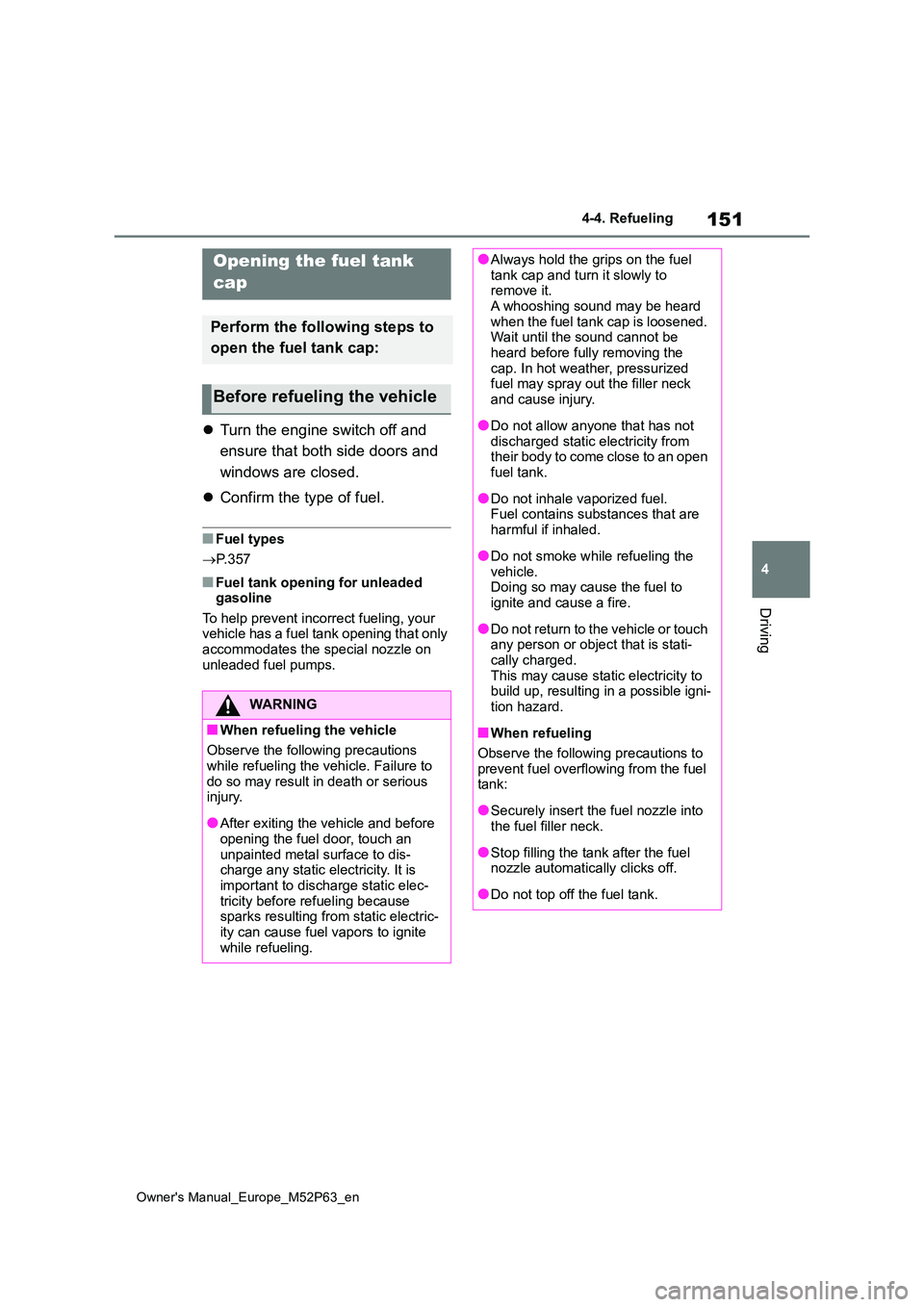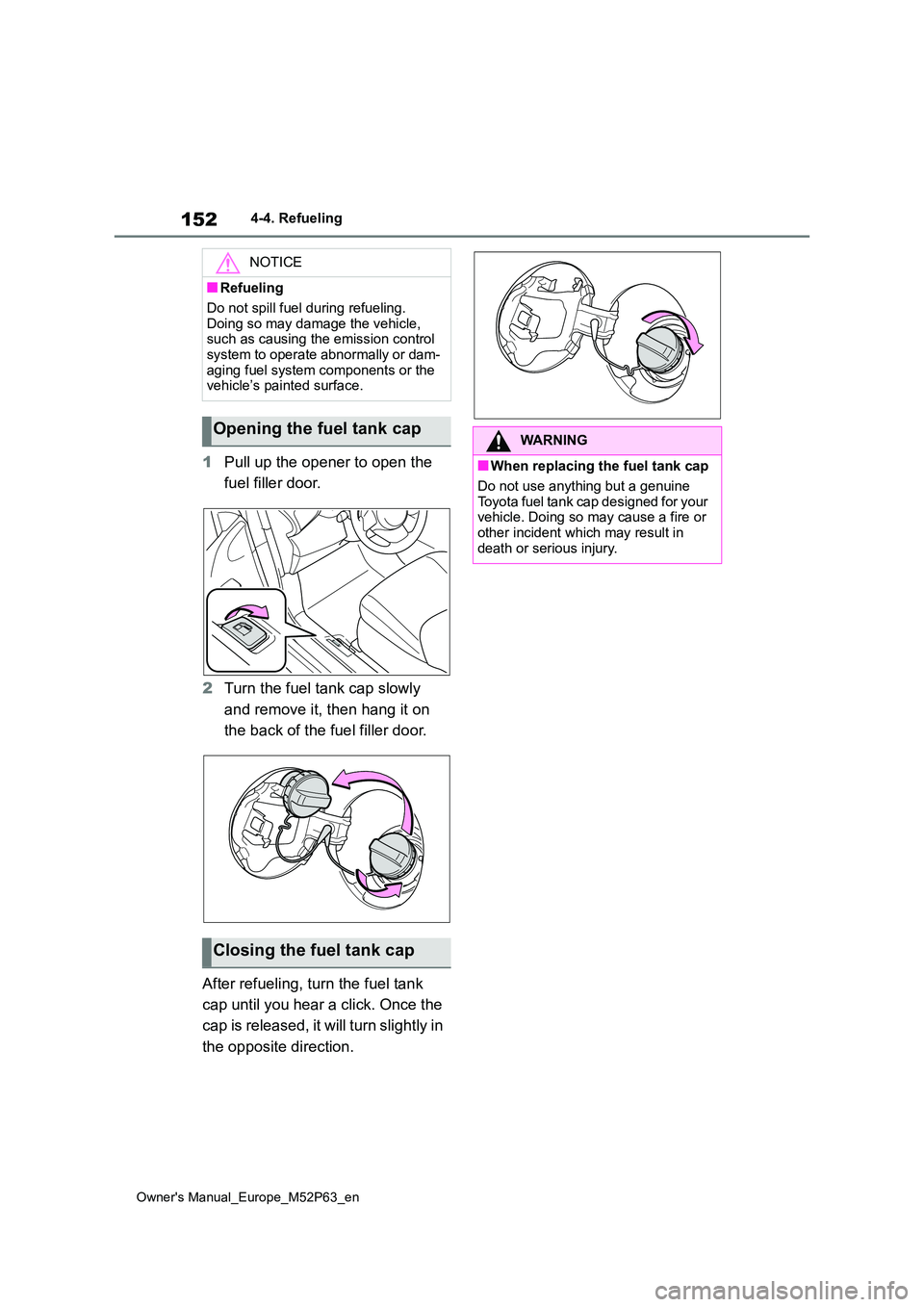2022 TOYOTA GR YARIS fuel cap
[x] Cancel search: fuel capPage 5 of 470

3
Owner's Manual_Europe_M52P63_en
TABLE OF CONTENTS
1
6
5
4
3
2
8
7
4-3. Operating the lights and wip-
ers
Headlight switch.................. 142
Automatic High Beam ......... 145
Fog light switch ................... 148
Windshield wipers and washer
.......................................... 148
4-4. Refueling
Opening the fuel tank cap ... 151
4-5. Using the driving support sys-
tems
Toyota Safety Sense ........... 153
PCS (Pre-Collision System) 158
LTA (Lane Tracing Assist) ... 170
Dynamic radar cruise control
.......................................... 179
RSA (Road Sign Assist) ...... 190
Stop & Start system ............ 194
BSM (Blind Spot Monitor) ... 199
Toyota parking assist-sensor
.......................................... 204
RCTA (Rear Crossing Traffic
Alert) ................................. 210
AWD mode select switch .... 215
GPF (Gasoline Particulate Filter)
system .............................. 216
Driving assist systems ........ 217
4-6. Driving tips
Winter driving tips ............... 224
5-1. Using the air conditioning
system and defogger
Automatic air conditioning sys-
tem.................................... 228
Heated steering wheel/seat
heaters.............................. 233
5-2. Using the interior lights
Interior lights list .................. 235
5-3. Using the storage features
List of storage features ....... 237
Luggage compartment features
.......................................... 239
5-4. Other interior features
Other interior features ......... 242
6-1. Maintenance and care
Cleaning and protecting the
vehicle exterior ................. 246
Cleaning and protecting the
vehicle interior .................. 249
6-2. Matte paint care guide (if
equipped)
Basic knowledge about matte
clear coat .......................... 252
Washing your vehicle.......... 256
Frequently Asked Questions
.......................................... 259
6-3. Maintenance
Maintenance requirements . 263
5Interior features
6Maintenance and care
Page 15 of 470

13
Owner's Manual_Europe_M52P63_en
Pictorial index
Refueling method .............................................................................P.152
Fuel type/fuel tank capacity ................................... ..........................P.350
Tires .......................................................... ......................................P.275
Tire size/inflation pressure ................................... ............................P.355
Winter tires/tire chains ....................................... ..............................P.224
Checking/rotation/tire pressure warning system ................. .............P.275
Coping with flat tires......................................... ................................P.323
Hood ........................................................... .....................................P.266
Opening ........................................................ ...................................P.266
Engine oil ..................................................... ....................................P.350
Coping with overheating ........................................ ..........................P.344
Headlights/front position lights/daytime running lights/turn si gnal
lights ......................................................... ..............................P.140, 142
Front fog lights............................................... ................................P.148
Tail lights/turn signal lights ................................. .................P.140, 142
Stop lights
Side turn signal lights ........................................ ...........................P.140
License plate light............................................ ..............................P.142
Rear fog light ................................................. .................................P.148
Back-up light
Shifting the shift position to R ............................... ...........................P.137
Light bulbs of the exterior lights for driving
(Replacing method: P.299, Watts: P.355)
Page 127 of 470

4
125
Owner's Manual_Europe_M52P63_en
4
Driving
Driving
4-1. Before driving
Driving the vehicle ............ 126
Cargo and luggage ........... 132
Trailer towing .................... 133
4-2. Driving procedures
Engine (ignition) switch..... 134
Manual transmission......... 137
Turn signal lever ............... 140
Parking brake ................... 141
4-3. Operating the lights and wip-
ers
Headlight switch ............... 142
Automatic High Beam ....... 145
Fog light switch ................. 148
Windshield wipers and washer
....................................... 148
4-4. Refueling
Opening the fuel tank cap. 151
4-5. Using the driving support
systems
Toyota Safety Sense ......... 153
PCS (Pre-Collision System)
........................................ 158
LTA (Lane Tracing Assist) . 170
Dynamic radar cruise control
........................................ 179
RSA (Road Sign Assist) .... 190
Stop & Start system .......... 194
BSM (Blind Spot Monitor) . 199
Toyota parking assist-sensor
........................................ 204
RCTA (Rear Crossing Traffic
Alert) ............................... 210
AWD mode select switch .. 215
GPF (Gasoline Particulate Fil-
ter) system ...................... 216
Driving assist systems ...... 217
4-6. Driving tips
Winter driving tips ............. 224
Page 153 of 470

151
4
Owner's Manual_Europe_M52P63_en
4-4. Refueling
Driving
4-4.Refuelin g
Turn the engine switch off and
ensure that both side doors and
windows are closed.
Confirm the type of fuel.
■Fuel types
P. 3 5 7
■Fuel tank opening for unleaded gasoline
To help prevent incorrect fueling, your vehicle has a fuel tank opening that only accommodates the special nozzle on
unleaded fuel pumps.
Opening the fuel tank
cap
Perform the following steps to
open the fuel tank cap:
Before refueling the vehicle
WARNING
■When refueling the vehicle
Observe the following precautions
while refueling the vehicle. Failure to do so may result in death or serious injury.
●After exiting the vehicle and before opening the fuel door, touch an
unpainted metal surface to dis- charge any static electricity. It is important to discharge static elec-
tricity before refueling because sparks resulting from static electric-ity can cause fuel vapors to ignite
while refueling.
●Always hold the grips on the fuel tank cap and turn it slowly to remove it.
A whooshing sound may be heard when the fuel tank cap is loosened. Wait until the sound cannot be
heard before fully removing the cap. In hot weather, pressurized fuel may spray out the filler neck
and cause injury.
●Do not allow anyone that has not
discharged static electricity from their body to come close to an open fuel tank.
●Do not inhale vaporized fuel.Fuel contains substances that are
harmful if inhaled.
●Do not smoke while refueling the
vehicle. Doing so may cause the fuel to ignite and cause a fire.
●Do not return to the vehicle or touch any person or object that is stati-
cally charged. This may cause static electricity to build up, resulting in a possible igni-
tion hazard.
■When refueling
Observe the following precautions to prevent fuel overflowing from the fuel tank:
●Securely insert the fuel nozzle into the fuel filler neck.
●Stop filling the tank after the fuel nozzle automatically clicks off.
●Do not top off the fuel tank.
Page 154 of 470

152
Owner's Manual_Europe_M52P63_en
4-4. Refueling
1Pull up the opener to open the
fuel filler door.
2 Turn the fuel tank cap slowly
and remove it, then hang it on
the back of the fuel filler door.
After refueling, turn the fuel tank
cap until you hear a click. Once the
cap is released, it will turn slightly in
the opposite direction.
NOTICE
■Refueling
Do not spill fuel during refueling.
Doing so may damage the vehicle, such as causing the emission control system to operate abnormally or dam-
aging fuel system components or the vehicle’s painted surface.
Opening the fuel tank cap
Closing the fuel tank cap
WARNING
■When replacing the fuel tank cap
Do not use anything but a genuine
Toyota fuel tank cap designed for your vehicle. Doing so may cause a fire or other incident which may result in
death or serious injury.
Page 291 of 470

289
6
Owner's Manual_Europe_M52P63_en
6-4. Do-it-yourself maintenance
Maintenance and care
■Effects of incorrect tire inflation pressure
Driving with incorrect tire inflation pres- sure may result in the following:
●Reduced safety
●Damage to the drive train
●Reduced tire life due to wear
●Reduced fuel economy
●Reduced driving comfort and poor
handling
If a tire needs frequent inflating, have it checked by any authorized Toyota
retailer or Toyota authorized repairer, or any reliable repairer.
■Instructions for checking tire infla-tion pressure
When checking tire inflation pressure, observe the following:
●Check only when the tires are cold.If your vehicle has been parked for at least 3 hours or has not been driven
for more than 1.5 km or 1 mile, you will get an accurate cold tire inflation pressure reading.
●Always use a tire pressure gauge.It is difficult to judge if a tire is properly
inflated based only on its appearance.
●It is normal for the tire inflation pres-
sure to be higher after driving as heat is generated in the tire. Do not reduce
tire inflation pressure after driving.
●Passengers and luggage weight
should be placed so that the vehicle is balanced.
WARNING
■Proper inflation is critical to save
tire performance
Keep your tires properly inflated. If the tires are not properly inflated,
the following conditions may occur which could lead to an accident resulting in death or serious injury:
●Excessive wear
●Uneven wear
●Poor handling
●Possibility of blowouts resulting from overheated tires
●Air leaking from between tire and wheel
●Wheel deformation and/or tire dam-age
●Greater possibility of tire damage while driving (due to road hazards,
expansion joints, sharp edges on the road, etc.)
NOTICE
■When inspecting and adjusting
tire inflation pressure
Be sure to put the tire valve caps back on.
If a valve cap is not installed, dirt or moisture may get into the valve and cause an air leak, resulting in
decreased tire inflation pressure.
Page 350 of 470

348
Owner's Manual_Europe_M52P63_en
8-1. Specifications
8-1.Spec ific ations
*: Unladen vehicles
■Vehicle identification number
The vehicle identification number
(VIN) is the legal identifier for your
vehicle. This is the primary identifi-
cation number for your Toyota. It is
used in registering the ownership of
your vehicle.
This number is stamped under the
right-hand front seat.
On some models, this number is
also stamped on the top left of the
instrument panel.
This number is also on the manu-
facturer’s label.
Maintenance data (fuel, oil level, etc.)
Dimensions and weights
Overall length3995 mm (157.3 in.)
Overall width1805 mm (71.1 in.)
Overall height*1445 mm (56.9 in.)
Wheelbase2560 mm (100.8 in.)
TreadFront1535 mm (60.4 in.)
Rear1565 mm (61.6 in.)
Gross vehicle mass1645 kg (3627 lb.)
Maximum permissible axle
capacity
Front970 kg (2138 lb.)
Rear900 kg (1984 lb.)
Vehicle identification
Page 352 of 470

350
Owner's Manual_Europe_M52P63_en
8-1. Specifications
*: If unleaded gasoline with a Research Octane Number of 98 is not available,
unleaded gasoline with a Research Octane Number of 95 may be us ed with no
detriment to engine durability or driveability.
■Oil capacity (Drain and refill
[Reference*])
*: The engine oil capacity is a reference
quantity to be used when changing
the engine oil. Warm up and turn off
the engine, wait more than 8 minutes,
and check the oil level on the dip-
stick.
■Engine oil selection
Gasoline Engine
“Toyota Genuine Motor Oil” is used
in your Toyota vehicle. Toyota rec-
ommends the use of approved
“Toyota Genuine Motor Oil”.
Another motor oil of matching qual-
ity can also be used.
Oil grade:
API grade SN PLUS “Resource-
Conserving” or SP “Resource-Con-
serving”; or ILSAC GF-6A multi-
grade engine oil
Recommended viscosity (SAE):
SAE 0W-20
Fuel
Fuel type
When you find these types of fuel label at
the gas station, use only the fuel with one
of the following labels.
EU area:
Unleaded gasoline conforming to Euro-
pean standard EN228 only
Except EU area:
Unleaded gasoline only
Research Octane Number98 or higher*
Fuel tank capacity
(Reference)50.0 L (13.2 gal., 11.0 Imp. gal.)
Lubrication system
With filter4.3 L (4.5 qt., 3.7 Imp. qt.)
Without fil-
ter4.0 L (4.2 qt., 3.5 Imp. qt.)